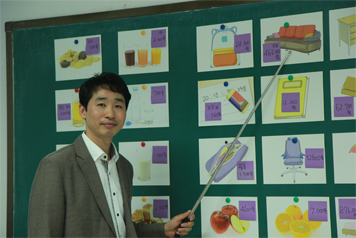
KSI People Stories
Promoting Korean language and culture through KSI
The Person of May
Oh Jae-nam from the Tianjin 2 KSI

Hello, Mr. Oh! Can you introduce yourself and the Tianjin 2 KSI?
I am Oh Jae-nam, and I teach Korean at Tianjin 2 KSI. I’ve been teaching at the Tianjin 2 KSI for over 2 years, and it has been 5 years since I started working as a teacher at KSI. The KSI in Tianjin where I am currently working was opened on July 2015, and we have many working students since we offer evening and weekend classes.
Who was the most memorable student while you’ve been working as a teacher at KSI?
I would say the employees of the ‘LG Household & Health Care Hangzhou Factory’. When I was working at the Hangzhou KSI from 2014 to 2016, I taught Korean language twice a week at the ‘LG Household & Health Care Hangzhou Factory’. The scheduled class time is from 11 to 11:30, but the students were eager to learn and they even reduced their lunch break in order to study until 12:15. They not only studied Korean very hard, but also helped and cared for each other. I still remember the warm and kind hearts of the LG Household & Health Care employees including Xu Xiaoping, the class leader, who always helped other students with their writing homework before the class started and Jiang Ping, the secretary, who always looked after the attendance rate of students.
What made you want to become a Korean language teacher?
I began by teaching Korean to my Chinese wife. My major is Korean literature, and I was dreaming of something other than being a Korean teacher, but I met my wife while I was studying abroad in China. We had no problem with communicating in Chinese, but my wife and my family struggled to communicate in Korean. I started to take an interest in Korean language education in order to help my wife, and I ended up obtaining a teacher’s certificate for Korean language in 2013.
What kinds of things should Chinese learners be aware of when learning Korean?
Chinese learners have difficulties with pronouncing sounds with their mouth closed. And since local dialects are very distinct in China, Korean pronunciations of learners differ by the place they were born. That’s why I pay close attention to improving pronunciation in my class. Also, Chinese leaners tend to get stuck in one stage if they don’t understand the grammar fully, so I prepare the grammar lessons thoroughly by making Chinese grammar materials.
Finally, what is KSI to you?
KSI is ‘rewarding’ to me. When I see Chinese students who could not say a single word in Korean begin to read and say ‘Annyeonghaseyo’, or when students eat the Tteokbokki that we made at a KSI event and laugh together, I feel a sense of satisfaction. I feel quite rewarded by promoting Korean language and culture at KSI.

